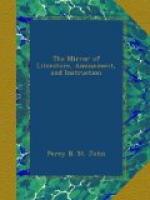[12] Sir Henry Wootton’s Elements of Architecture.
[13] Evelyn’s Diary.
In 1820, the poet of Marmion was created a baronet, by George IV., but a few weeks after his accession—it being the first baronetcy conferred by the King, and standing alone in the Gazette which announced the honour. In 1822, Sir Walter distinguished himself in the loyal reception of the King, on his visit to Scotland; and soon afterwards the Baronet was appointed a deputy-lieutenant for the county of Roxburgh.
EMBARRASSMENTS.
Thus stood the “pure contents” of Abbotsford, when, in January, 1826, the failure of Messrs. Constable threw a gloom over Sir Walter’s affairs. The eminent publisher had been one of his earliest friends. “Archie Constable,” he once said, “was a good friend to me long ago, and I will never see him at a loss.” The sums given by Mr. Constable for the copyright of Sir Walter’s novels were nominally immense; but they were chiefly paid in bills, which were renewed as the necessities of the publisher increased, till, on his failure, Sir Walter found himself responsible for various debts, amounting to 102,000_l_. About this time Lady Scott died, and her loss was an additional affliction to him. Various modes of settlement were proposed to Sir Walter for the liquidation of these heavy debts; but, “like the elder Osbaldistone of his own immortal pages, considering commercial honour as dear as any other honour,” he would only consent to payment in full; and, in the short space of six years, he paid off 60,000_l._ “by his genius alone; but he crushed his spirit in the gigantic struggle, or, in plain words, sacrificed himself in the attempt to repair his broken fortunes.” He sold his house and furniture in Edinburgh, and, says Chambers, “retreated into a humble lodging in a second-rate street (St. David-street, where David Hume had formerly lived.)” He reduced his establishment at Abbotsford, and retired, as far as his official duties would permit, from public life, accompanied only by his younger daughter. In this domestic retreat, at fifty-five years of age, he commenced
THE LIFE OF NAPOLEON BUONAPARTE
—visiting France, in 1826, for some information requisite to the work. In the following summer the Life appeared in nine volumes, an extent much beyond the original project. As might be expected, from the aristocratical turn of Sir Walter’s political tenets, the opinions on this work were more various than on any other of his productions: it is, to say the best, the most faulty and unequal of them all; and, considering how clearly this has been shown, it is somewhat surprising to hear so clever a critic as Mr. Cunningham pronounce The Life of Napoleon as “one of the noblest monuments of Scott’s genius.” We pass from these considerations to the excellence of the purpose to which the proceeds (12,000_l._) of this work were applied—namely, to the payment of 6_s._ 8_d._ in the pound, as the first dividend of the debts of the author.




